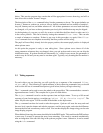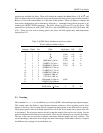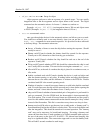
October 30, 1997
13
object time name Setup for object
object prepares qcdcom to take an exposure of a general target. You can specify
integration time as the first argument and an object name as the second. The object
command sets the automatic actions: # of resets: 1, shutter on, readout on.
Example: object 300 N3031 (set integration time to 300 sec and object name
to N3031) Example: object 0.18 (set integration time to 0.18 sec )
auto set automatic action
auto goes through the choices for the automatic actions, and allows you to set each.
You should not normally need to use auto directly, since you can use the object,
dark, etc. commands for most normal exposures. It is provided for those who need
to do fancy things. The automatic actions are:
#reset: n Number of times to reset the chip before starting the exposure. Should
usually be set to 1.
Shutter on/off Controls whether the shutter should be opened for the exposure.
Usually set to ON, otherwise no flux from sky gets to detector.
Readout on/off Controls whether the chip should be read out at the end of the
exposure. Usually ON.
Write on/off Controls whether a FITS file should be written after the chip is read
out. Usually ON to save data. This can also be set using the command set save.
idle on/off If on, at the end of a readout the chip is placed in a continuous reset, or
idle, mode.
double correlated read on/off Controls whether the device is read out before and
after the shutter opening, or only after. If reading before and after, the difference
between the two are taken, and this difference is written to the FITS file. Double
correlated read ON is the normal operating mode.
Number of samples n controls how many frames to co-add in the double correlated
read. For each exposure, the chip will be reset and read n times before opening the
shutter, and read n times after the shutter closes. Usually set to 1.
chop on/off Controls whether a beamswitched pair of integrations is performed for
each go command. If at the UH 88-inch, the beamswitch is done automatically.
Use with caution. The on and off source frames are differenced and the result is
stored in a file with the name constructed from the data file name plus “chop” added
instead of the file number. This file is overwritten every time a new chop is done.
dummy read on/off In order to get the array into a stable mode, a “dummy read" is
done immediately before the read that is saved as data. This occurs both before and
after the integration. This should be turned on for normal operation. The "dummy
read" may not be necessary for broad-band imaging. Not using a dummy read
causes the first three lines of each quadrant to be slightly unstable with respect to
the rest of the array on the level of 5-10 ADU’s. For narrow-band imaging, this
may be a significant effect. The conservative approach is to use the dummy read.
This will add 5 seconds overhead to each image.


















